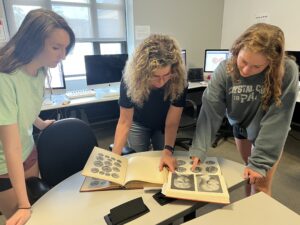Editor’s Note: This year’s MUSE (Mentored Undergraduate Summer Experience) Poster Session, held on Sept. 15, featured a handful of projects within the School of the Arts and Communication. Below is one of the featured projects.
Connections made during a three-week study tour to Greece evolved into a faculty-student research collaboration.
 During the study tour, Professor of Art History and Classical Studies Lee Ann Riccardi met Shayna Carter, a junior mechanical engineering major, and Leah Lavender, a junior criminology and psychology major. Riccardi saw that the two were interested in learning about the ancient world and they got along well together. She soon offered the students the opportunity to conduct research alongside her as part of TCNJ’s Mentored Undergraduate Summer Experience (MUSE).
During the study tour, Professor of Art History and Classical Studies Lee Ann Riccardi met Shayna Carter, a junior mechanical engineering major, and Leah Lavender, a junior criminology and psychology major. Riccardi saw that the two were interested in learning about the ancient world and they got along well together. She soon offered the students the opportunity to conduct research alongside her as part of TCNJ’s Mentored Undergraduate Summer Experience (MUSE).
The MUSE program allows students to work directly with professors on their research and help them to continue their work. These students live and work on campus over the span of eight weeks, and present their findings at the beginning of the fall semester each year.
Carter and Lavender presented their work, “The Roman Emperor Seen from the Provinces: Imaging Roman Power in the Cities of the Empire (31 B.C.-A.D. 297),” at this fall’s MUSE Poster Session.
“I’ve never done research of any type before, and any research experience is better than no research experience. It was also something way out of my realm of possibilities while on campus, so I thought it would be really fun,” Lavender said.
 Riccardi first got involved in the project when she heard from one of her colleagues that the lead investigator was given a grant from the European Union to create an open access database. She had been conducting similar research, and knew this would give her a better chance of getting her work out to the public and getting to work with other scholars with the same goal. She offered her findings and then joined the team as a senior collaborator.
Riccardi first got involved in the project when she heard from one of her colleagues that the lead investigator was given a grant from the European Union to create an open access database. She had been conducting similar research, and knew this would give her a better chance of getting her work out to the public and getting to work with other scholars with the same goal. She offered her findings and then joined the team as a senior collaborator.
The project consisted of studying portraits of emperors on Roman coins. The students would compare coins against each other to see which were the same, and would then categorize them and analyze why they were different. The word “tedious” was used by all three members to describe the research, as hours were spent looking at very similar coins depicting the same emperor, and going through city by city.
“I always thought research was something a little bit more involved. Breakthrough after breakthrough every day, something new. I think what I realized through this is that is not at all what research is. It’s just collecting a little bit of data over time. Then maybe at the end, you’ll get a breakthrough. Who knows?” Carter said.
 The MUSE program places a heavy emphasis on the importance of research and the skills anyone can take away from it, no matter what field they are in. Carter, for example, does not plan on studying more bronze coins in the future, but instead hopes to do material science within museums. She explained that along with a mechanical engineering degree, her research experience will definitely help to make this possible.
The MUSE program places a heavy emphasis on the importance of research and the skills anyone can take away from it, no matter what field they are in. Carter, for example, does not plan on studying more bronze coins in the future, but instead hopes to do material science within museums. She explained that along with a mechanical engineering degree, her research experience will definitely help to make this possible.
“I think for me, the biggest thing had to be watching them and their progress as they grew in confidence about what they were doing, and grew to really understand more of the bigger picture,” Riccardi said. “Not just the tiny little details of what we were doing, but to try to understand more about what the bigger project really was.”
– Grace Murphy ’26
